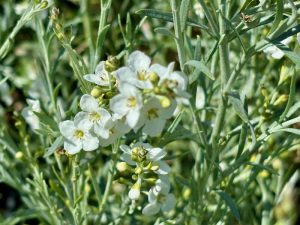Gomphostigma virgatum: The Silver Mist of the Garden
Gomphostigma virgatum, known commonly as Otterbossie, is a graceful evergreen shrub that adds silvery elegance to gardens with its arching habit and willow-like leaves. Native to Southern Africa, this plant is celebrated for its slender grey stems and its ability to bloom for months on end, from early summer right through mid-autumn. Though not native to Britain or Ireland, it’s gaining popularity in temperate gardens worldwide, especially where texture, contrast, and a long blooming period are desired.
Belonging to the family Scrophulariaceae, Gomphostigma virgatum also has ties to the Buddlejaceae family in some classifications. It reaches up to 2.5 meters (about 6 to 8 feet) in height and spreads 60 to 120 cm (2 to 4 feet) wide, forming a bushy, vase-shaped silhouette. Its evergreen, narrow leaves and feathery white flowers make it a standout feature near water features, borders, or mixed shrub beds.
Description and Seasonal Interest
This South African native has silver-grey, flexible branches and oppositely arranged, slender leaves that resemble those of willow trees. The foliage offers a soft, luminous contrast in garden compositions, especially when paired with dark greens or bold colors.
From late spring to autumn, Gomphostigma virgatum produces delicate white flowers with a subtle fragrance. These four-petaled blooms appear in graceful sprays and flutter gently in the breeze, creating a romantic, meadow-like feel. In the Southern Hemisphere, flowering peaks in summer, especially during December and January. The plant’s airy floral display and shimmering leaves make it attractive even when not in bloom.
How to Grow Gomphostigma virgatum
Light
Gomphostigma virgatum prefers full sun but will tolerate light shade. For the best flower production and foliage coloration, give it at least 6 hours of direct sunlight per day. In regions with very hot summers, afternoon shade may help preserve leaf color and prevent scorch.
Soil
Plant it in well-draining soil with moderate to rich fertility. Although it can tolerate some seasonal wetness, especially near ponds or streams, the roots should not sit in waterlogged conditions. A loamy or sandy soil amended with compost works well.
Watering
Regular irrigation helps maintain lush growth and prolonged blooming. While the plant can handle short dry spells once established, it performs best with consistent moisture, especially during hot months. Near water gardens or with drip irrigation, Gomphostigma virgatum can thrive beautifully.
Fertilizing
Feed in spring with a balanced, slow-release fertilizer to support foliage growth and flower development. In lean soils, a second feeding mid-summer can help sustain blooming. Avoid excessive nitrogen, which may result in lanky growth and fewer flowers.
Pruning
Cut back hard after winter or flowering to maintain shape and encourage dense new growth. Removing older, woody stems will also improve air circulation and flowering. Pruning also helps to manage size and keeps the plant looking fresh and bushy.
Propagation of Gomphostigma virgatum
This shrub is very easy to propagate. Semi-hardwood cuttings taken during the growing season root quickly in moist, well-draining media. Simple layering also works well—just peg down a young branch under a bit of soil and wait for roots to develop before severing it from the parent plant.
Seeds can be used but are less commonly available and more time-consuming. For gardeners looking to multiply a mature specimen, cuttings remain the most efficient option.
Pests and Diseases
Gomphostigma virgatum is not particularly susceptible to pests or diseases, making it a low-maintenance choice for many gardens. In poorly ventilated sites or excessively wet conditions, fungal issues like grey mold (Botrytis) may appear, especially during cool, damp weather. To prevent this, ensure good air circulation and allow the topsoil to dry slightly between waterings.
Garden Uses for Gomphostigma virgatum
This plant’s soft texture and upright, arching form make it an excellent candidate for water gardens, stream edges, and pond borders. It pairs well with ornamental grasses, salvias, and other drought-tolerant perennials.
Gomphostigma virgatum also works beautifully in large containers, especially in climates where overwintering in-ground isn’t feasible. In mixed borders, its silver foliage acts as a visual foil to bold-flowered plants, enhancing both contrast and cohesion.
Because of its height and ethereal flowers, it can serve as a structural yet soft element at the back of a border. In modern garden designs, it brings a wild yet refined character.
Traditional and Cultural Notes
In its native habitat, Gomphostigma virgatum has had several traditional uses. The plant is believed to restore strength in exhausted individuals and is also used for making brooms from its long, flexible twigs—especially before flowering occurs. In rural areas, livestock are known to browse on it when available.
These functional uses add another layer of appreciation for a plant already admired for its ornamental beauty.
Final Thoughts on Gomphostigma virgatum
Elegant, easy to grow, and adaptable, Gomphostigma virgatum deserves wider recognition among gardeners seeking drought-tolerant but visually soft plants. Its graceful habit, shimmering foliage, and delicate white blooms offer charm over a long season. Whether near a pond, in a container, or dancing between grasses in a sunny border, this South African native adds light and elegance wherever it’s planted.



